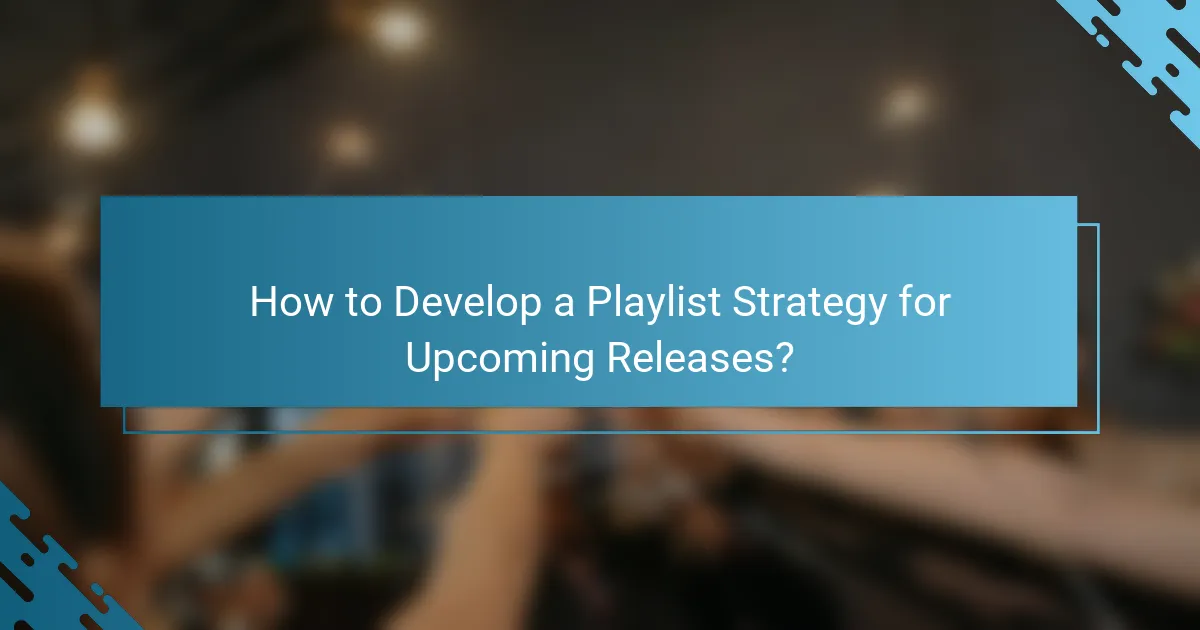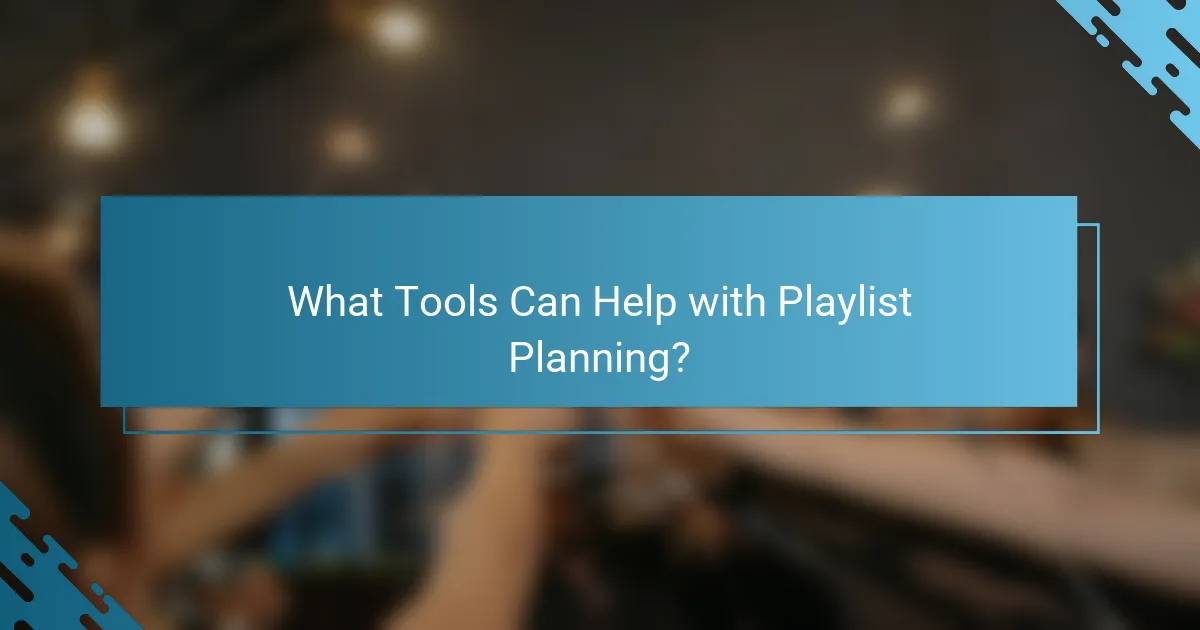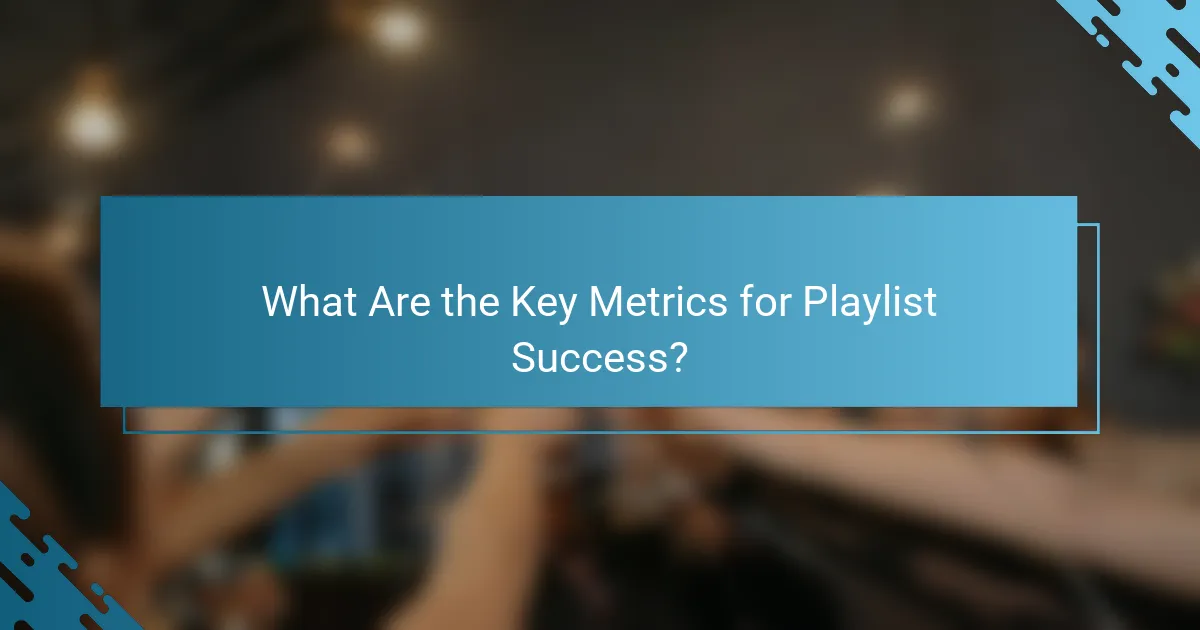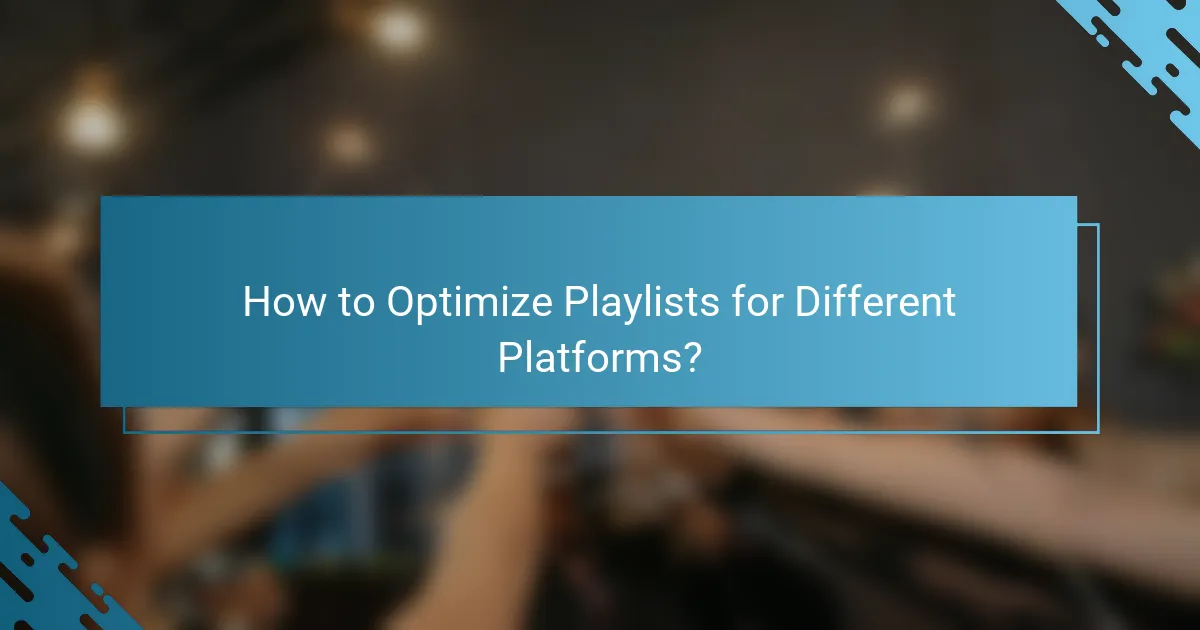Creating a successful playlist strategy for upcoming releases involves understanding your audience, establishing a clear timeline, and choosing the appropriate distribution platforms. By leveraging analytical tools and monitoring key performance metrics, artists can enhance their visibility and engagement, ensuring their music reaches the right listeners at the optimal time.

How to Develop a Playlist Strategy for Upcoming Releases?
To develop an effective playlist strategy for upcoming releases, focus on understanding your audience, setting a clear timeline, and selecting the right platforms for distribution. This approach ensures that your music reaches the right listeners at the right time, maximizing engagement and impact.
Identify target audience
Identifying your target audience is crucial for tailoring your playlist strategy. Consider demographics such as age, location, and musical preferences to create playlists that resonate with listeners. Utilize analytics from streaming platforms to gather insights about who is engaging with your music.
Engage with your audience through social media and surveys to refine your understanding. This direct feedback can help you curate playlists that align with their tastes, increasing the likelihood of your music being shared and added to personal playlists.
Define release timeline
Establishing a release timeline is essential for coordinating your playlist strategy. Aim for a schedule that allows sufficient time for promotion before the release date, typically ranging from a few weeks to a couple of months. This gives you the opportunity to build anticipation and engage your audience effectively.
Consider seasonal trends and significant dates in the music industry when planning your timeline. Aligning your releases with events or holidays can enhance visibility and relevance, making your music more likely to be included in curated playlists.
Choose platforms for distribution
Selecting the right platforms for distributing your music is vital for reaching your audience. Popular streaming services like Spotify, Apple Music, and YouTube offer various playlist opportunities, each with unique audience demographics. Research which platforms your target audience frequents most.
Utilize digital distribution services that can help you get your music onto multiple platforms simultaneously. This approach maximizes exposure and ensures that your music is accessible to listeners across different services.
Collaborate with artists and labels
Collaboration with other artists and labels can significantly enhance your playlist strategy. Partnering with artists who have a similar audience can introduce your music to new listeners and increase your chances of being featured on popular playlists.
Reach out to labels that have experience in your genre. They often have established relationships with playlist curators and can provide valuable insights and opportunities for collaboration that can boost your visibility.
Analyze competitor strategies
Analyzing the strategies of competitors can provide valuable insights into effective playlist tactics. Study how similar artists promote their releases and the types of playlists they target. This can help you identify successful approaches and potential gaps in the market.
Keep track of which playlists include your competitors’ music and note their engagement levels. Use this information to inform your own playlist placements and refine your strategy to better compete in the same space.

What Tools Can Help with Playlist Planning?
Effective playlist planning requires the right tools to analyze trends, track performance, and submit music for consideration. Utilizing platforms like Spotify for Artists, Chartmetric, Soundcharts, and SubmitHub can streamline the process and enhance your chances of success.
Spotify for Artists
Spotify for Artists is an essential tool for musicians to manage their profiles and gain insights into their audience. It provides data on streams, listener demographics, and playlist placements, allowing artists to tailor their releases and promotional strategies effectively.
To maximize its benefits, regularly check your analytics to identify which songs perform best and adjust your playlist submissions accordingly. Engaging with your audience through Spotify’s tools can also foster a loyal fanbase.
Chartmetric
Chartmetric offers a comprehensive analytics platform that tracks music performance across various streaming services and social media. This tool helps artists and managers understand market trends and identify potential playlists for their music.
Utilize Chartmetric to monitor competitors and discover new playlists that align with your genre. The platform’s ability to analyze data over time can guide your release strategy, helping you choose optimal timing for new music.
Soundcharts
Soundcharts provides real-time data on music trends and playlist placements, making it a valuable resource for artists looking to enhance their visibility. It aggregates information from multiple platforms, giving a holistic view of where your music is being played.
By leveraging Soundcharts, you can track your music’s performance and adapt your marketing strategies based on live data. This tool is particularly useful for identifying emerging trends and adjusting your playlist strategy accordingly.
SubmitHub
SubmitHub is a platform that connects artists with playlist curators, bloggers, and influencers for music submissions. It allows you to send your tracks directly to curators who are actively looking for new music, increasing your chances of getting featured.
When using SubmitHub, be strategic about your submissions. Research curators to ensure your music fits their style, and consider using the feedback feature to improve your tracks before resubmission. This targeted approach can lead to more successful placements.

What Are the Key Metrics for Playlist Success?
Key metrics for playlist success include stream counts, listener engagement, playlist adds and removals, and geographic reach. Monitoring these metrics helps artists and labels understand how well their music is performing and where to focus their promotional efforts.
Stream counts
Stream counts indicate how many times a track has been played on a playlist. High stream counts often correlate with popularity and can lead to increased visibility on streaming platforms. Aim for consistent growth in stream counts, as spikes can signal effective marketing or viral moments.
To evaluate stream counts effectively, compare your tracks against similar artists or genres. A good benchmark might be to target a growth rate of 10-20% month over month, depending on your genre’s typical performance.
Listener engagement
Listener engagement measures how actively listeners interact with a track, including saves, shares, and playlist additions. High engagement rates suggest that listeners are not only enjoying the music but are also motivated to promote it within their networks. Focus on creating compelling content that encourages listeners to engage.
To enhance listener engagement, consider using social media to connect with your audience. Engaging with fans through Q&A sessions or behind-the-scenes content can foster a deeper connection and increase interaction rates.
Playlist adds and removals
Playlist adds and removals reflect how often your tracks are included or excluded from playlists. Frequent adds indicate that curators find your music appealing, while removals may signal a need for improvement in quality or marketing. Track these changes to identify patterns in listener preferences.
To increase adds, target playlists that align with your genre and audience. Research curators and submit your music with personalized messages to improve your chances of being added.
Geographic reach
Geographic reach shows where your listeners are located, which can inform your marketing strategies. Understanding the regions where your music is most popular allows you to tailor promotional efforts and plan tours effectively. Use analytics tools to gather data on listener locations.
To expand your geographic reach, consider localized marketing campaigns or collaborations with regional artists. Engaging with fans in specific areas through targeted social media ads can also help grow your audience in those regions.

How to Optimize Playlists for Different Platforms?
To optimize playlists for different platforms, focus on understanding the unique algorithms and user behaviors of each service. Tailoring your approach can significantly enhance visibility and engagement for your music releases.
Spotify playlist optimization
Spotify’s algorithm favors playlists that engage listeners and encourage saves or shares. To optimize for Spotify, aim for a mix of popular tracks and lesser-known songs to maintain listener interest while also appealing to algorithmic recommendations.
Consider submitting your tracks to Spotify’s editorial playlists through Spotify for Artists at least a few weeks before release. Engage with your audience on social media to drive streams and encourage user-generated playlists featuring your music.
Apple Music playlist strategies
Apple Music relies heavily on curated playlists, often created by music experts. To optimize for this platform, focus on building relationships with curators and submitting your music for consideration on popular playlists.
Utilize Apple Music for Artists to track your performance and understand listener demographics. Engaging with fans through exclusive content or behind-the-scenes insights can also enhance your chances of being featured on playlists.
YouTube Music playlist considerations
YouTube Music’s algorithm promotes videos that keep viewers on the platform longer. To optimize playlists here, include a mix of music videos, lyric videos, and user-generated content to cater to diverse viewer preferences.
Regularly update your playlists to reflect new releases and trends. Encourage viewers to interact with your videos through comments and likes, as this engagement can improve your visibility in YouTube’s recommendations.

What Are Common Mistakes in Playlist Strategy?
Common mistakes in playlist strategy often stem from a lack of understanding of audience needs and insufficient use of data analytics. These oversights can lead to ineffective playlists that fail to engage listeners and miss opportunities for growth.
Neglecting audience preferences
Neglecting audience preferences can severely impact the effectiveness of a playlist. Understanding what your listeners enjoy is crucial; this includes their favorite genres, artists, and even specific songs. Conducting surveys or analyzing listener feedback can provide valuable insights.
To avoid this mistake, regularly engage with your audience through social media or music platforms. Use tools like polls or comment sections to gather direct input on what they want to hear. Tailoring your playlists to these preferences can significantly enhance listener satisfaction and retention.
Ignoring data analytics
Ignoring data analytics means missing out on critical insights that can inform your playlist strategy. Metrics such as play counts, skip rates, and listener demographics can reveal what works and what doesn’t. Utilizing these analytics helps in making data-driven decisions that align with audience behavior.
To effectively incorporate data analytics, use platforms that provide detailed performance metrics. Regularly review this data to identify trends and adjust your playlists accordingly. For example, if a particular genre is gaining traction, consider featuring more tracks from that category to capitalize on the interest.
